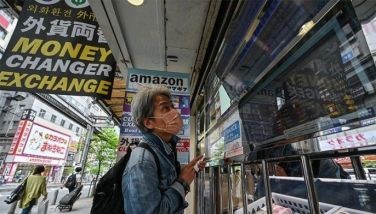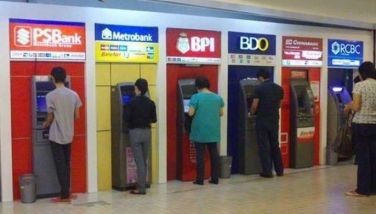Scenarios for the peso
Since we started this column in Feb. 2005, Philequity has made three major calls on the peso. First was our call of the peso’s bottom in 2005 (see Peso, the Strongest Currency in Asia, Oct. 24, 2005). Second was our call of the peso’s top last year (see The Peso Tops Out, May 27, 2013).
Third and most recent was our call that the peso’s support level at 45.50–46 will hold (see EM Currency Contagion, Jan. 27, 2014). The peso indeed found support at 45.485 on Feb. 4, 2014, a week after we published our call. Since then, the peso has strengthened by 2.3 percent against the US dollar to close at 44.50 last Friday.
USD:PHP Rate (2005 to Present)

Source: Fxtop.com, Wealth Securities Research
Monetary conditions to tighten
Following the US Fed’s latest move to step up the gradual removal of its bond-buying program, the Bangko Sentral ng Pilipinas is closely monitoring domestic credit/liquidity conditions.
“If liquidity growth continues to be strong even as the inflation outlook stays manageable, we will not hesitate to again consider further pre-emptive macroprudential measures,†according to BSP Governor Amando Tetangco.
Not by raising rates but by other tools
With inflation expectations broadly aligned with their target of 3-5 percent in 2014 and two to four percent in 2015, the BSP has kept its overnight borrowing rate at 3.5 percent. It, however, raised bank reserve requirements to 19 percent from 18 percent last month. While it avoided tweaking policy rates, the hike in reserve requirements was intended to guard against potential price pressures that could arise from continued strong liquidity growth and rapid credit expansion.
Verbal intervention
Another tool that central banks, like the BSP, have successfully used to influence the market is giving forward guidance through verbal intervention (see Don’t Fight the Bangko Sentral, Feb.17, 2014). This means telegraphing or hinting future actions by using words to show what it intends to do.
The peso rose last week after market participants heeded BSP’s hints that further adjustments in monetary policy tools are being considered. By giving forward guidance, the BSP intends to influence and put to maximum effect its policy tool adjustments.
BSP at the helm
While the BSP remains market-oriented, it was successful in smoothing out excessive volatility when fears of another emerging market currency crisis were high following the Argentine bolivar’s devaluation early this year (see EM Currency Contagion, Jan. 27, 2014). With all the tools available in its arsenal in adjusting to challenging global conditions, the BSP remains clearly at the helm.
EM currencies recover
As the peso rallied against the US dollar the last three months, other emerging market currencies recovered as well. In fact, the “fragile five†currencies (Brazilian real, South African rand, Turkish lira, Indonesian rupiah and the Indian rupee), which were last year’s worst performers, led the rally this year.
As mentioned in a previous article, troubled emerging market economies which suffered last year when the US Fed started tapering its bond buying program have started fixing their problems (see Best House in an Improving Neighborhood, Feb. 24, 2014). India and Indonesia have reduced their current account deficits while South Africa and Brazil have raised rates.

Source: Wealth Securities Research
The table above shows that “fragile five†currencies gained an average of 9.6 percent from their recent lows. Meanwhile, the peso has rebounded 2.2 percent from its low which is at par with the region’s 2.3 percent move against the greenback.
Possible scenarios for the peso
Given the tightening monetary conditions and strengthening regional EM currencies, we believe that the peso can further strengthen towards 44 or even lower. From a technical standpoint, we also believe that we have seen the intermediate lows of the peso at 45.50 vs. the US dollar.
We now see two likely scenarios unfolding for the peso:
Scenario 1: The first scenario calls for the peso going as high as 44 to the dollar. It would then trade in the 44 to 45.50 range.

Source: Wealth Securities Research
Scenario 2: The second scenario calls for the peso breaking below 44 and heading towards 43. The rally of the PSE index, EM stocks and EM currencies will be the catalysts for this move. In case the PSE index rallies to new highs, we may even see a sharper appreciation towards 42. In this scenario, we may see the peso ranging between 42 and 45.50 longer term.

Source: Wealth Securities Research
For further stock market research and to view our previous articles, please visit our online trading platform at www.wealthsec.com or call 634-5038. Our archived articles can also be viewed at www.philequity.net.
- Latest
- Trending

































